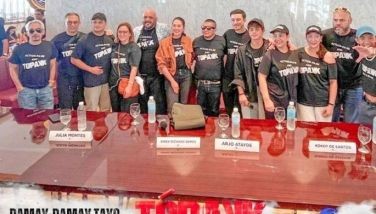Industry lessons from filmmaker-animator Avid Liongoren
CEBU, Philippines — Director and animator Avid Liongoren knows a thing or two about filming on a budget.
His company Rocketsheep Studio has done music videos for Yeng Constantino and Nadine Lustre as well as commercials for brands like PLDT and Red Ribbon. But you might have heard of his name if you’ve seen the animation-live-action hybrid “Saving Sally” or the full animation “Hayop Ka! The Nimfa Dimaano Story.”
“If somebody tells you to make a 90-second commercial with P2 million, you’re gonna be worried that it’s not enough,” he tells The FREEMAN in an interview during the Sugbo Entertainment Expo.
“But if somebody tells you ‘Hey, here’s P2 million, make a 90-minute film’, you’re going to think ‘Kaya ko yan’ because you’re thinking of it as an indie production, while commercials have a different approach. When I’m shooting a film, I might do three takes. When shooting a commercial, I will do 40 takes of one shot. Commercials are seen so many times so you have to make sure what they are seeing holds up to being watched again and again.”
During his keynote speech at the expo, Liongoren shared his thoughts on why Filipino animated films are rarely being made. In an industry used to shooting on a tight schedule with a short turnaround, developing an animated film that usually takes years to produce is not financially sustainable for local studios.
Describing his storytelling style as “whimsical” and “silly”, the filmmaker from Manila likes to have humans and drawings co-exist.
He learned a lot from making his feature debut “Saving Sally” which had been under development for almost a decade. When the original producers pulled out, reshoots had to be done when new financiers came on board.
“Saving Sally” was a surreal romantic-comedy about aspiring comic book artist Marty (Enzo Marcos) who has feelings for his best friend Sally (Rhian Ramos). Marty sees himself rescuing Sally from various animated monsters, including a narcissistic boyfriend nicknamed “Nick the Dick” (TJ Trinidad) who is a “penis monster” in the male protagonist’s vivid imagination.
Ramos was around 19 or 20 years old when she replaced the original actress Anna Larrucea in the reshoots. She was 26 when the film was finally released in cinemas during the 2016 Metro Manila Film Festival.
“We have a sales agent now because of what happened with ‘Saving Sally.’ Now, we have a sales agent who will sell the film after we complete it. It’s kind of like having a manager,” he explained.
‘TV Patrol acting’
His second feature “Hayop Ka”, released on Netflix in 2020, features Angelica Panganiban lending her voice to the titular role of Nimfa, an anthropomorphic cat who gets caught up in a love triangle between her boyfriend Roger (Robin Padilla) and wealthy tycoon Iñigo (Sam Milby), both of which are anthropomorphic dogs.
“My personal experience wasn’t so great because we sold ‘Hayop Ka!’ at the height of the pandemic and we didn’t have a lot of options. We sold it because we needed enough money to survive,” he said, before clarifying that “Netflix is a great platform where a lot of people can see your film. That’s all every filmmaker wants anyway – for their films to be accessible. We are still figuring out the money part.”
While “Hayop Ka” satirizes tropes in Filipino films and teleseryes, it garnered mixed reactions as critics disliked the film for its “misogynistic undertones.”
“That’s their view and I have no control over that. It wasn’t meant to be sexist. We have a female protagonist who decided to leave all the guys in her life, so I don’t know why they would think it’s sexist. But it’s their opinion and I cannot change that. You make a film, it doesn’t belong to you anymore.”
One of the things that pushed this criticism was a scene of Nimfa who called a misogynistic late-night radio DJ (voiced by Piolo Pascual who produced the film with director Joyce Bernal) for relationship advice, only to berate her over the airwaves. He stressed that the film is not endorsing humiliation towards the female lead, but mirrors the Filipino society’s need for self-gratification.
“The deeper cultural aspect is, it’s like going to a confessional and talking to the priest. When you have a night DJ to talk to about your problems, you don’t expect to be enlightened,” said Liongoren. “We listen to people being berated, we don’t listen for proper advice. It’s just this weird Filipino act of self-flagellation that shows how we don’t have access to mental health professionals, so we seek help in weird ways.”
“It’s like Tulfo. Because we don’t trust the law, we don’t trust the lawyers, and we don’t trust the system, we trust Tulfo just like that! We cherry-pick what happens in our culture that exists. Filipinos are very performative. Put a camera on them, they’ll cry and smile afterward. It’s like TV Patrol acting.”
Animated Zsazsa Zaturnnah
Liongoren’s next project is the animated adaptation of “Zsazsa Zaturnnah”, a comic book superhero created by Carlo Vergara. It is a gay parody and homage to Darna and Zsa Zsa Padilla who played the titular character in the 2006 film by Regal Entertainment.
In previews shown to the expo audience, the dialogue is entirely in English by Manila theater actors as it’s an international film with backing from French producers and a British sales agent.
Since Zaturnnah is heavily based on Filipino pop culture references, how would an English version turn out? “The international version isn’t so reliant on Filipino pop culture. It just has this silly concept of a shy gay man who swallows a rock and then becomes a female superhero. It’s the gay Shazam-ness of it all,” he shared.
Liongoren assured that the superhero’s “Filipino campiness” doesn’t get lost in translation in Vergara’s script. They eventually plan to dub the film in Filipino.
“The Filipino version is going to be funnier when we get around to doing it because that’s where we can put in all of the Darna analogies and other Filipino pop culture,” he remarked.
AI takeover
With the rise of generative artificial intelligence (AI) that can emulate certain animation styles from studios like Pixar in a matter of minutes, Liongoren admits being worried of its impact on the animation sector.
“I am not in the camp of people who are secure and think that AI will never take over. As long as business people want to make and maximize profits over human labor, it doesn’t matter if humans can do a better job. If AI can produce content cheaper and faster, that’s where business people will go,” he said.
While he concedes AI is of good use to filmmakers for “boring” tasks such as image stabilization, Liongoren believes that unless there is government regulation to protect human workers, “AI is going to take over and kick us out of work.”
- Latest
























